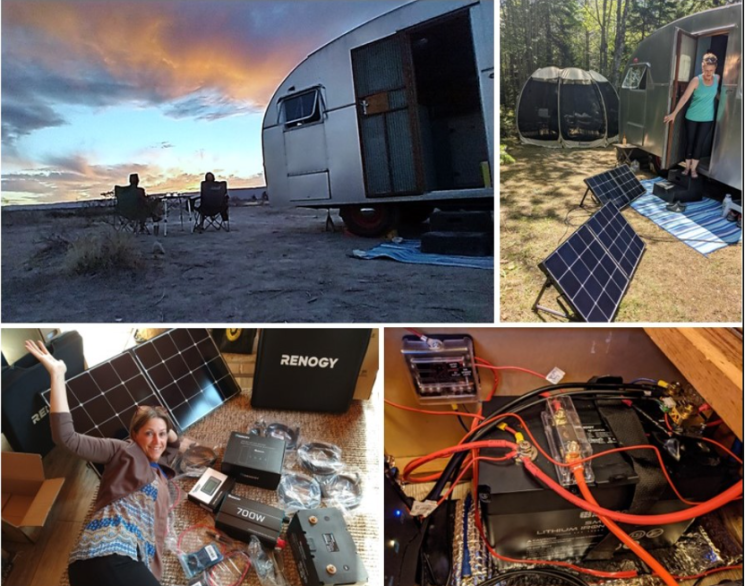You need a lot of electricity in the mobile home for the constant power supply of the radio, heating, light and refrigerator and for the operation of an inverter and other electrical devices. The supply battery enables independent power supply. It is charged by the alternator while driving and ideally by the solar system on the roof when stationary. The more electrical consumers are connected, the greater the capacity (Ah) of the mobile home battery must be. Various battery technologies with different advantages and disadvantages are available.
The most important things at a glance:
Wet batteries score with a low price.
Gel batteries last longer, can be discharged more deeply, but are not suitable for high currents.
AGM batteries impress with high cycle stability and supply demanding consumers.
Lithium RV batteries are the ultimate for the highest demands and constant use.
What is an on-board battery?
On-board batteries are supply batteries. The batteries store electrical energy on an electrochemical basis. The classic 12 volt lithium battery with lead-acid technology consist of six cells with a voltage of 2 volts each. Each cell has two sets of plates immersed in dilute sulfuric acid. The material of the positive plate sets is lead dioxide, the negative plate(s) are made of lead.
Supply batteries with lead technology have thicker lead plates compared to starter batteries, are optimized for constant power consumption and are much more cycle-resistant. The supply batteries tolerate deep discharges up to 75 percent better. The other properties depend on the respective battery technology.
Which on-board battery do I need for my mobile home?
The first step is to decide on a battery type. You can choose from classic wet batteries, advanced lead-acid batteries and modern lithium batteries.
Wet batteries for mobile homes: the inexpensive choice for entry
RV wet batteries with liquid electrolyte are entry-level models. Their structure is similar to that of starter batteries. The manufacturers optimize the cycle stability with thicker lead plates. Older models may outgas and will require a breather hose. Modern wet batteries, on the other hand, are maintenance-free. These are mostly dual-purpose batteries for engine starting and power supply. You cannot install these classic lead-acid batteries at an angle. The installation should also take place in an acid-proof tub.
Advantages:
Cheap price
Low-maintenance or maintenance-free
high currents
Disadvantages:
Not leakproof
Higher self-discharge
Danger of outgassing
Reduced lifespan
Recommendation: Wet batteries are suitable for low deep discharge and when the mobile home is usually connected to shore power.
VRLA RV batteries: maintenance free, leak proof and vibration resistant.
VRLA (valve-regulated lead-acid) RV batteries are advanced sealed lead-acid batteries. They do not gas, are suitable for indoor use and require no maintenance. You don’t have to and can’t top up with distilled water. VRLA batteries are leak-proof and can be used in an inclined position ? under the passenger seat is a typical installation location. The cycle stability of the VRLA supply batteries is about twice as high as that of the maintenance-free wet batteries. There are two types: Gel and AGM batteries.
Gel batteries (VRLA) for operation in the interior of the mobile home
In lead-gel batteries, silica binds the electrolyte and turns it into a gel-like state. Due to the high internal resistance, the battery type is not suitable for delivering high currents. The manufacturers optimize the batteries for the constant power supply of small consumers over long periods of time. The advantages of these supply batteries include low self-discharge and cycle stability. They survive high depths of discharge without premature wear. However, performance drops at low temperatures.
Advantages:
Maintenance-free and leak-proof
Can be used in an inclined position
Vibration and shake resistant
Withstands deep discharges
Ideal for the permanent power supply of small consumers
Disadvantages:
Not suitable for delivering high currents
Less efficient in cold temperatures
Longer charging time
Recommendation: Gel batteries are well suited if you want to constantly supply small consumers with electricity and do not connect any power-hungry devices.
AGM batteries supply power-hungry devices in mobile homes and when camping
Supply batteries with AGM technology (absorbent glass mat) integrate glass fleece mats that absorb the electrolyte. This results in excellent vibration and impact resistance, and installation can take place at an angle. Due to the lower internal resistance, AGM batteries reliably deliver high currents and, for example, supply demanding devices such as hair dryers and coffee machines with power using an inverter. Another advantage: The batteries charge comparatively quickly, which is practical for self-sufficient operation with a solar system. They are used as a starter battery in modern cars with a start-stop system. They are the preferred choice in motorhomes with many devices switched on at the same time. Low temperatures do not affect performance, so winter campers usually choose AGM batteries.
Advantages:
Maintenance-free and leak-proof
Can be installed in an inclined position
Vibration and shake resistant
Also delivers high currents
Can be easily combined with solar
Fast loading time
Disadvantages:
heat sensitive
Lithium batteries for continuous use and the highest demands in mobile homes
Compared to lead-acid batteries, lithium batteries for motorhomes weigh significantly less with the same nominal capacity. Since you can use the capacity almost completely if required and lithium batteries can not only be deeply discharged to 75 percent, you also benefit from the higher energy yield. The energy density of lithium iron phosphate (LiFePO4) batteries is three times higher, one lithium battery replaces two gel or AGM batteries.
Another selling point is the excellent cycle stability. The lithium iron phosphate batteries last much longer, so the higher purchase price is well worth it over the years.
Even when not in use, the lithium battery scores thanks to its minimal self-discharge. If the motorhome is parked in a garage in winter, you should occasionally connect gel and AGM batteries to a charger and charge them fully. Otherwise, sulphation occurs more quickly in a partially charged state. Lithium batteries( such as lifepo4 battery ), on the other hand, can be stored partially charged, around 50 to 70 percent is recommended.
In addition, lithium batteries are intrinsically safe. The lithium-ion batteries in smartphones can deform and catch fire. The advanced RV lithium iron phosphate batteries have a different construction. They are maintenance-free, leak-proof and there is no risk of explosion.
Advantages:
Maintenance-free, leak-proof
Can be installed in any position
Extremely high cycle stability
High energy density
Faster charging
Long lifetime
Minimal self-discharge
Disadvantages:
High purchase price
How big does the on-board battery for the mobile home have to be?
The required capacity (Ah) of the camper battery depends on how much power the connected devices in the vehicle consume and how many hours you use them before the battery is charged by the alternator, solar system or shore power. So the question is how long you want to camp independently in nature without sacrificing the convenience of electrical consumers. You calculate the required capacity (Ah) by balancing the average consumption.
To do this, list the electrical devices with their power consumption values ??and multiply them by the typical duty cycle. If you also sleep in the mobile home in winter, you should create a separate balance for the cold season due to the higher electricity requirements.
Example of calculating the power consumption:
Compressor fridge: 40 watts * 8 hours = 320 Wh
Light: 10 watts * 4 hours = 40 Wh
Laptop: 50 watts * 2 hours = 100 Wh
Total: 460 Wh / 12 volts = 38 Ah daily power requirement
With a lead-acid battery, you will achieve maximum durability if you only discharge it to 50 percent. In the example, this corresponds to an on-board battery with 76 Ah. When operating with solar generators, it is important to plan for a bad weather reserve. After all, the sun doesn’t shine every day.
How long would you like to camp independently in nature?
In order to ensure the power supply of the devices in the example for three days without shore power and sunshine, you need a supply battery with around 230 Ah. If you decide to buy a lithium battery, a capacity of around 135 Ah is sufficient, as you can discharge it much more deeply. In addition, the lithium battery can absorb energy faster in strong sunshine.
Charge the on-board battery correctly
Even the best quality battery is useless and wears out quickly if not charged correctly. The right charging process is essential for the on-board battery to achieve the charging cycles promised by the manufacturer.
While driving, the alternator charges the supply battery.
In combination with a solar system, the charge controller ensures correct charging. It must match the battery type.
When connecting to the 230 volt network, the charger must be designed for battery technology. Modern chargers with IuoU characteristics can be adjusted to the battery type. The end-of-charge voltage is 14.4 volts for wet and gel batteries and 14.8 volts for AGM batteries. Lithium batteries charge faster, suitable LiFePO4 chargers are marked accordingly.
Summary
For a small to medium-sized motorhome with few and undemanding consumers, the performance of a deep-cycle wet battery is sufficient; a gel battery is more cycle-resistant.
If you want to use a larger inverter with power-hungry devices such as a hair dryer or coffee maker, an AGM battery is a better choice. Investing in a lithium battery is worthwhile for the highest demands.





